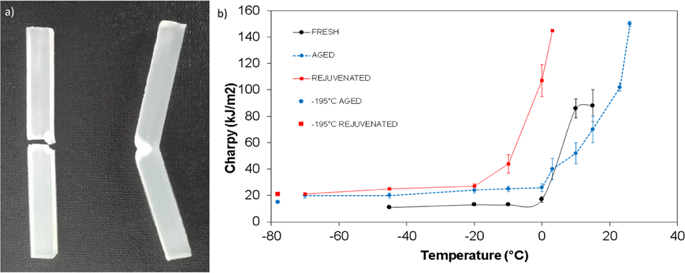Our official English website, www.x-mol.net, welcomes your
feedback! (Note: you will need to create a separate account there.)
Polypropylene after thirty years of storage: mechanical proof of heterogeneous aging
Polymer Journal ( IF 2.3 ) Pub Date : 2020-03-24 , DOI: 10.1038/s41428-020-0327-8 Marta Sližová , Martin Stašek , Miroslav Raab
Polymer Journal ( IF 2.3 ) Pub Date : 2020-03-24 , DOI: 10.1038/s41428-020-0327-8 Marta Sližová , Martin Stašek , Miroslav Raab

|
The effects of 30 years of storage on the mechanical behavior and hierarchical structure of isotactic polypropylene were characterized. In addition, the structure and properties of the aged samples exposed to subsequent annealing were assessed. The long-term storage caused a dramatic loss of ductility, as manifested by the strain-at-break and impact strength data. The embrittlement was accompanied by a distinct increase in the crystallinity of both the alpha and beta phases, as revealed by X-ray diffraction. The dynamic mechanical behavior was influenced, but insignificantly. A comparison of static and dynamic mechanical data suggests the development of structural heterogeneities in the amorphous phase of the semicrystalline material upon aging. Under mechanical stress, these heterogeneities serve as fracture loci. Subsequent annealing of the aged samples partly reversed the loss of ductility. This indicates healing of the hypothetical irregularities by the thermal treatment. In addition, annealing caused complete transformation of the beta crystallites into the alpha phase. Long-term storage of isotactic polypropylene caused a dramatic loss of ductility, as manifested by the mechanical tensile and impact behavior. The embrittlement was accompanied by an increase in the crystallinity. A comparison of static and dynamic mechanical data suggests the development of structural heterogeneities upon aging that serve as fracture loci under mechanical stress. Subsequent annealing of the aged samples reversed the loss of ductility. This indicates healing of the hypothetical irregularities by the thermal treatment.
中文翻译:

聚丙烯储存 30 年后:异质老化的机械证明
表征了 30 年储存对全同立构聚丙烯的力学行为和分级结构的影响。此外,还评估了经过后续退火处理的老化样品的结构和性能。断裂应变和冲击强度数据表明,长期储存会导致延展性急剧下降。X 射线衍射表明,脆化伴随着 α 相和 β 相结晶度的明显增加。动态力学行为受到影响,但影响不大。静态和动态机械数据的比较表明,半结晶材料的非晶相在老化时会出现结构异质性。在机械应力下,这些异质性充当断裂位点。老化样品的后续退火部分逆转了延展性的损失。这表明通过热处理修复了假设的不规则性。此外,退火导致β微晶完全转变为α相。全同立构聚丙烯的长期储存会导致延展性急剧下降,如机械拉伸和冲击行为所证明的那样。脆化伴随着结晶度的增加。静态和动态力学数据的比较表明,老化后结构异质性的发展,作为机械应力下的断裂位点。老化样品的后续退火逆转了延展性的损失。这表明通过热处理修复了假设的不规则性。这表明通过热处理修复了假设的不规则性。此外,退火导致β微晶完全转变为α相。全同立构聚丙烯的长期储存会导致延展性急剧下降,如机械拉伸和冲击行为所证明的那样。脆化伴随着结晶度的增加。静态和动态力学数据的比较表明,老化后结构异质性的发展,作为机械应力下的断裂位点。老化样品的后续退火逆转了延展性的损失。这表明通过热处理修复了假设的不规则性。这表明通过热处理修复了假设的不规则性。此外,退火导致β微晶完全转变为α相。全同立构聚丙烯的长期储存会导致延展性急剧下降,如机械拉伸和冲击行为所证明的那样。脆化伴随着结晶度的增加。静态和动态力学数据的比较表明,老化后结构异质性的发展,作为机械应力下的断裂位点。老化样品的后续退火逆转了延展性的损失。这表明通过热处理修复了假设的不规则性。退火导致β微晶完全转变为α相。全同立构聚丙烯的长期储存会导致延展性急剧下降,如机械拉伸和冲击行为所证明的那样。脆化伴随着结晶度的增加。静态和动态力学数据的比较表明,老化后结构异质性的发展,作为机械应力下的断裂位点。老化样品的后续退火逆转了延展性的损失。这表明通过热处理修复了假设的不规则性。退火导致β微晶完全转变为α相。全同立构聚丙烯的长期储存会导致延展性急剧下降,如机械拉伸和冲击行为所证明的那样。脆化伴随着结晶度的增加。静态和动态力学数据的比较表明,老化后结构异质性的发展,作为机械应力下的断裂位点。老化样品的后续退火逆转了延展性的损失。这表明通过热处理修复了假设的不规则性。脆化伴随着结晶度的增加。静态和动态力学数据的比较表明,老化后结构异质性的发展,作为机械应力下的断裂位点。老化样品的后续退火逆转了延展性的损失。这表明通过热处理修复了假设的不规则性。脆化伴随着结晶度的增加。静态和动态力学数据的比较表明,老化后结构异质性的发展,作为机械应力下的断裂位点。老化样品的后续退火逆转了延展性的损失。这表明通过热处理修复了假设的不规则性。
更新日期:2020-03-24
中文翻译:

聚丙烯储存 30 年后:异质老化的机械证明
表征了 30 年储存对全同立构聚丙烯的力学行为和分级结构的影响。此外,还评估了经过后续退火处理的老化样品的结构和性能。断裂应变和冲击强度数据表明,长期储存会导致延展性急剧下降。X 射线衍射表明,脆化伴随着 α 相和 β 相结晶度的明显增加。动态力学行为受到影响,但影响不大。静态和动态机械数据的比较表明,半结晶材料的非晶相在老化时会出现结构异质性。在机械应力下,这些异质性充当断裂位点。老化样品的后续退火部分逆转了延展性的损失。这表明通过热处理修复了假设的不规则性。此外,退火导致β微晶完全转变为α相。全同立构聚丙烯的长期储存会导致延展性急剧下降,如机械拉伸和冲击行为所证明的那样。脆化伴随着结晶度的增加。静态和动态力学数据的比较表明,老化后结构异质性的发展,作为机械应力下的断裂位点。老化样品的后续退火逆转了延展性的损失。这表明通过热处理修复了假设的不规则性。这表明通过热处理修复了假设的不规则性。此外,退火导致β微晶完全转变为α相。全同立构聚丙烯的长期储存会导致延展性急剧下降,如机械拉伸和冲击行为所证明的那样。脆化伴随着结晶度的增加。静态和动态力学数据的比较表明,老化后结构异质性的发展,作为机械应力下的断裂位点。老化样品的后续退火逆转了延展性的损失。这表明通过热处理修复了假设的不规则性。这表明通过热处理修复了假设的不规则性。此外,退火导致β微晶完全转变为α相。全同立构聚丙烯的长期储存会导致延展性急剧下降,如机械拉伸和冲击行为所证明的那样。脆化伴随着结晶度的增加。静态和动态力学数据的比较表明,老化后结构异质性的发展,作为机械应力下的断裂位点。老化样品的后续退火逆转了延展性的损失。这表明通过热处理修复了假设的不规则性。退火导致β微晶完全转变为α相。全同立构聚丙烯的长期储存会导致延展性急剧下降,如机械拉伸和冲击行为所证明的那样。脆化伴随着结晶度的增加。静态和动态力学数据的比较表明,老化后结构异质性的发展,作为机械应力下的断裂位点。老化样品的后续退火逆转了延展性的损失。这表明通过热处理修复了假设的不规则性。退火导致β微晶完全转变为α相。全同立构聚丙烯的长期储存会导致延展性急剧下降,如机械拉伸和冲击行为所证明的那样。脆化伴随着结晶度的增加。静态和动态力学数据的比较表明,老化后结构异质性的发展,作为机械应力下的断裂位点。老化样品的后续退火逆转了延展性的损失。这表明通过热处理修复了假设的不规则性。脆化伴随着结晶度的增加。静态和动态力学数据的比较表明,老化后结构异质性的发展,作为机械应力下的断裂位点。老化样品的后续退火逆转了延展性的损失。这表明通过热处理修复了假设的不规则性。脆化伴随着结晶度的增加。静态和动态力学数据的比较表明,老化后结构异质性的发展,作为机械应力下的断裂位点。老化样品的后续退火逆转了延展性的损失。这表明通过热处理修复了假设的不规则性。











































 京公网安备 11010802027423号
京公网安备 11010802027423号